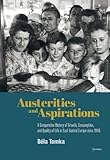Austerities and Aspirations : A Comparative History of Growth, Consumption, and Quality of Life in East Central Europe since 1945 / Béla Tomka.
Material type: TextPublisher: Budapest ; New York : Central European University Press, [2022]Copyright date: ©2020Description: 1 online resource (456 p.)Content type:
TextPublisher: Budapest ; New York : Central European University Press, [2022]Copyright date: ©2020Description: 1 online resource (456 p.)Content type: - 9789633863527
- Economic development -- Europe, Eastern -- History -- 20th century
- Post-communism -- Europe, Eastern -- History -- 20th century
- Quality of life -- Europe, Eastern -- History -- 20th century
- HISTORY / Europe / Eastern
- Communism, Consumption, East and West, Economic development, Economic history, Postcommunism
- 338.9437 23
- HC244 .T64546 2020
- HC244 .T64546 2020
- online - DeGruyter
| Item type | Current library | Call number | URL | Status | Notes | Barcode | |
|---|---|---|---|---|---|---|---|
 eBook
eBook
|
Biblioteca "Angelicum" Pont. Univ. S.Tommaso d'Aquino Nuvola online | online - DeGruyter (Browse shelf(Opens below)) | Online access | Not for loan (Accesso limitato) | Accesso per gli utenti autorizzati / Access for authorized users | (dgr)9789633863527 |
Browsing Biblioteca "Angelicum" Pont. Univ. S.Tommaso d'Aquino shelves, Shelving location: Nuvola online Close shelf browser (Hides shelf browser)

|

|

|

|

|

|

|
||
| online - DeGruyter Gorbachev and Bush : The Last Superpower Summits. Conversations that Ended the Cold War / | online - DeGruyter Gorbachev and Reagan : The Last Superpower Summits. Conversations that Ended the Cold War / | online - DeGruyter In the Name of History / | online - DeGruyter Austerities and Aspirations : A Comparative History of Growth, Consumption, and Quality of Life in East Central Europe since 1945 / | online - DeGruyter Forest Brothers : The Account of an Anti-Soviet Lithuanian Freedom Fighter, 1944–1948 / | online - DeGruyter Stalin's Italian Prisoners of War / | online - DeGruyter Avala Is Falling / |
Frontmatter -- Contents -- Foreword -- 1 Introduction: Comparisons and the Triple Approach to Well-Being -- 2 Economic Growth: Catching Up and Falling Behind -- 3 Consumption: Structures, Practices, and Policies -- 4 Quality of Life: Towards a More Comprehensive Understanding of Well-Being -- 5 Determinants of Change: Accounting for Growth and Beyond -- 6 Passages to the New Millennium: The Evolving Order of Divisions -- 7 Conclusions: Lessons of the Triple Approach -- Appendix -- Notes -- Bibliography -- Index
restricted access online access with authorization star
http://purl.org/coar/access_right/c_16ec
This monograph provides an analysis of the economic performance and living standard in Czechoslovakia and its successor states, Hungary, and Poland since 1945. The novelty of the book lies in its broad comparative perspective: it places East Central Europe in a wider European framework that underlines the themes of regional disparities and European commonalities. Going beyond the traditional growth paradigm, the author systematically studies the historical patterns of consumption, leisure, and quality of life—aspects that Tomka argues can best be considered in relation to one other. By adopting this “triple approach,” he undertakes a truly interdisciplinary research drawing from history, economics, sociology, and demography. As a result of Tomka’s three-pillar comparative analysis, the book makes a major contribution to the debates on the dynamics of economic growth in communist and postcommunist East Central Europe, on the socialist consumer culture along with its transformation after 1990, and on how the accounts on East Central Europe can be integrated into the emerging field of historical quality of life research.
Mode of access: Internet via World Wide Web.
In English.
Description based on online resource; title from PDF title page (publisher's Web site, viewed 30. Aug 2022)


